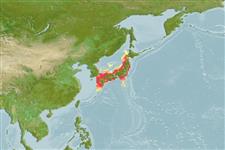Beobachtung melden im Fish Watcher
| Native range | All suitable habitat | Point map | Year 2050 |

|
| This map was computer-generated and has not yet been reviewed. |
| Trachurus japonicus AquaMaps Data sources: GBIF OBIS |
Hochladen Photos und videos
Pictures | Google BildTrachurus japonicus
Picture by Shao, K.T.
Pictures | Google BildTrachurus japonicus
Picture by Shao, K.T.
Chinese Taipei (Taiwan) country information
Common names:
[No common name]
Occurrence: native
Salinity: brackish
Abundance: | Ref:
Importance: commercial | Ref: FAO, 2000
Aquaculture: | Ref:
Regulations: | Ref:
Uses: no uses
Comments: Known from southern (commonly found in Nanwan) (Ref. 43538) and northern (abundantly found in Shihman and commonly in Yehliu (Ref. 43538); also from Tung-hsiao, Tai-chung and Chang-hwa) Taiwan, and Peng-hu (Ref. 43515). Also Ref. 559, 55073.
National Checklist:
Country Information: https://www.cia.gov/library/publications/resources/the-world-factbook/geos/tw.html
National Fisheries Authority:
Occurrences: Occurrences Point map
Main Ref: Kuo, S.-R. and K.-T. Shao, 1999
National Database: The Fish Database of Taiwan
Occurrence: native
Salinity: brackish
Abundance: | Ref:
Importance: commercial | Ref: FAO, 2000
Aquaculture: | Ref:
Regulations: | Ref:
Uses: no uses
Comments: Known from southern (commonly found in Nanwan) (Ref. 43538) and northern (abundantly found in Shihman and commonly in Yehliu (Ref. 43538); also from Tung-hsiao, Tai-chung and Chang-hwa) Taiwan, and Peng-hu (Ref. 43515). Also Ref. 559, 55073.
National Checklist:
Country Information: https://www.cia.gov/library/publications/resources/the-world-factbook/geos/tw.html
National Fisheries Authority:
Occurrences: Occurrences Point map
Main Ref: Kuo, S.-R. and K.-T. Shao, 1999
National Database: The Fish Database of Taiwan
Common names from other countries
Klassifizierung / Names Namen | Synonyme | Catalog of Fishes(Gattung, Arten) | ITIS | CoL | WoRMS | Cloffa
> Carangiformes (Jacks) > Carangidae (Jacks and pompanos) > Caranginae
Etymology: Trachurus: Greek, trachys, -eia, -ys = rough + Greek, oura = tail (Ref. 45335).
More on authors: Temminck & Schlegel.
Etymology: Trachurus: Greek, trachys, -eia, -ys = rough + Greek, oura = tail (Ref. 45335).
More on authors: Temminck & Schlegel.
Environment: milieu / climate zone / depth range / distribution range Ökologie
seewasser; ozeanodrom (Ref. 51243); tiefenbereich 0 - 275 m (Ref. 54927), usually 50 - 275 m (Ref. 54927). Tropical; 46°N - 13°N, 105°E - 148°E
Verbreitung Länder | FAO Gebiete | Ecosystems | Vorkommen | Point map | Einführungen | Faunafri
Northwest Pacific: southern Japan, Korean Peninsula to the East China Sea. Pacific Ocean off the coast of southeast Asia.
Length at first maturity / Size / Gewicht / Alter
Maturity: Lm 19.0, range 18 - 20 cm
Max length : 50.0 cm TL Männchen/unbestimmt; (Ref. 56557); common length : 35.0 cm TL Männchen/unbestimmt; (Ref. 56557); max. veröff. Gewicht: 660.00 g (Ref. 40637); max. veröff. Alter: 12 Jahre (Ref. 56557)
Max length : 50.0 cm TL Männchen/unbestimmt; (Ref. 56557); common length : 35.0 cm TL Männchen/unbestimmt; (Ref. 56557); max. veröff. Gewicht: 660.00 g (Ref. 40637); max. veröff. Alter: 12 Jahre (Ref. 56557)
Kurzbeschreibung Bestimmungsschlüssel | Morphologie | Morphometrie
Rückenflossenstacheln (insgesamt) : 9; Rückenflossenweichstrahlen (insgesamt) : 30 - 35; Afterflossenstacheln: 3; Afterflossenweichstrahlen: 26 - 30; Wirbelzahl: 24. Species with no finlets and the entire lateral line with scutes (69-73) (Ref. 41299).
Adults occur on continental waters (Ref. 41299). Pelagic (Ref. 52947). Juveniles associate with drifting seaweed (Ref. 12114, 12115).
Life cycle and mating behavior Geschlechtsreife | Fortpflanzung | Ablaichen | Eier | Fecundity | Larven
Hauptreferenz
Upload your references | Referenzen | Koordinator : Smith-Vaniz, William F. | Partner
Masuda, H., K. Amaoka, C. Araga, T. Uyeno and T. Yoshino, 1984. The fishes of the Japanese Archipelago. Vol. 1. Tokai University Press, Tokyo, Japan. 437 p. (text). (Ref. 559)
IUCN Rote Liste Status (Ref. 130435: Version 2024-2)
Gefährdung zunehmend (NT) (A2bd); Date assessed: 20 July 2017
Bedrohung für Menschen
Harmless
Nutzung durch Menschen
Fischereien: hoch kommerziell; Aquakultur: kommerziell
FAO(Aquaculture systems: production; Fischereien: production, Artbeschreibung; publication : search) | FishSource | Sea Around Us
Mehr Information
Population dynamics
Growth parameters
Max. ages / sizes
Length-weight rel.
Length-length rel.
Längenhäufigkeiten
Mass conversion
Rekrutierung
Dichte
Growth parameters
Max. ages / sizes
Length-weight rel.
Length-length rel.
Längenhäufigkeiten
Mass conversion
Rekrutierung
Dichte
Life cycle
Fortpflanzung
Geschlechtsreife
Fecundity
Ablaichen
Spawning aggregations
Eier
Eientwicklung
Larven
Larven Pop.Dyn.
Fortpflanzung
Geschlechtsreife
Fecundity
Ablaichen
Spawning aggregations
Eier
Eientwicklung
Larven
Larven Pop.Dyn.
Anatomy
Kiemenoberfläche
Brain
Otolith
Kiemenoberfläche
Brain
Otolith
Physiology
Body composition
Nutrients
Oxygen consumption
Swimming type
Swimming speed
Visual pigments
Fish sound
Diseases & Parasites
Toxicity (LC50s)
Body composition
Nutrients
Oxygen consumption
Swimming type
Swimming speed
Visual pigments
Fish sound
Diseases & Parasites
Toxicity (LC50s)
Human related
Aquaculture systems
Aquakultur Profile
Zuchtlinien
Ciguatera cases
Stamps, coins, misc.
Aquaculture systems
Aquakultur Profile
Zuchtlinien
Ciguatera cases
Stamps, coins, misc.
Tools
E-book | Feldführer | Längenhäufigkeits Tool | Lebensdaten Tool | Punkt Karte | Classification Tree
| Catch-MSY |
Zusatzinformationen
Download XML
Zusammenfassung | Point data | Namen | Photos
Internet Quellen
Aquatic Commons | BHL | Cloffa | BOLDSystems | Websites from users | FishWatcher Einträge suchen | CISTI | Catalog of Fishes(Gattung, Arten) | DiscoverLife | ECOTOX | Faunafri | Fishtrace | GenBank(Genom, nucleotide) | GloBI | GOBASE | | Google Books | Google Scholar | Google | IGFA World Record | MitoFish | Nationale Datenbanken | Otolith Atlas of Taiwan Fishes | PubMed | Reef Life Survey | Scirus | SeaLifeBase | Tree of Life | Wikipedia(Gehe zu, Suchen) | World Records Freshwater Fishing | Zoological Record
Estimates based on models
Preferred temperature (Ref. 115969): 1.8 - 22, mean 13.8 (based on 75 cells).
Phylogenetic diversity index (Ref. 82804): PD50 = 0.5001 [Uniqueness, from 0.5 = low to 2.0 = high].
Bayesian length-weight: a=0.01096 (0.00923 - 0.01302), b=2.97 (2.94 - 3.00), in cm Total Length, based on LWR estimates for this species (Ref. 93245).
Trophic level (Ref. 69278): 3.4 ±0.45 se; based on food items.
Widerstandsfähigkeit (Ref. 120179): mittel, Verdopplung der Population dauert 1,4 - 4,4 Jahre. (K=0.14-0.38; tmax=6).
Prior r = 0.55, 95% CL = 0.36 - 0.82, Based on 1 full stock assessment.
Fishing Vulnerability (Ref. 59153): Moderate vulnerability (35 of 100).
Climate Vulnerability (Ref. 125649): Low vulnerability (20 of 100).




